Related Research Articles

The Bengal tiger is a population of the Panthera tigris tigris subspecies and the nominate tiger subspecies. It ranks among the biggest wild cats alive today. It is considered to belong to the world's charismatic megafauna.
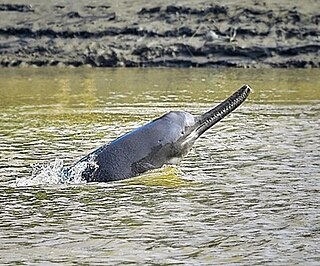
South Asian river dolphins are toothed whales in the genus Platanista, which inhabit the waterways of the Indian subcontinent. They were historically considered to be one species with the Ganges river dolphin and the Indus river dolphin being subspecies. Genetic and morphological evidence led to their being described as separate species in 2021. The Ganges and Indus river dolphins are estimated to have diverged 550,000 years ago. They are the only living members of the family Platanistidae and the superfamily Platanistoidea. Fossils of ancient relatives date to the late Oligocene.
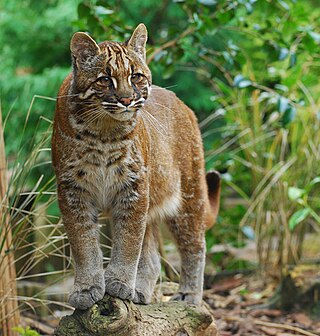
The Asian golden cat is a medium-sized wild cat native to the northeastern Indian subcontinent, Southeast Asia and China. It has been listed as Near Threatened on the IUCN Red List since 2008, and is threatened by poaching and habitat destruction, since Southeast Asian forests are undergoing the world's fastest regional deforestation.

The Indian rhinoceros, also known as the greater one-horned rhinoceros, great Indian rhinoceros, or Indian rhino for short, is a rhinoceros species native to the Indian subcontinent. It is the second largest extant species of rhinoceros, with adult males weighing 2.07–2.2 tonnes and adult females 1.6 tonnes. The skin is thick and is grey-brown in colour with pinkish skin folds. They have a single horn on their snout that grows to a maximum of 57.2 cm (22.5 in). Their upper legs and shoulders are covered in wart-like bumps. They are nearly hairless, aside from the eyelashes, ear fringes and tail brush.

The Terai or Tarai is to a lowland region in parts of northern India and southern Nepal that lies to the south of the outer foothills of the Himalayas, the Sivalik Hills and north of the Indo-Gangetic Plain. This lowland belt is characterised by tall grasslands, scrub savannah, sal forests and clay rich swamps. In North India, the Terai spreads from the Yamuna River eastward across Haryana, Uttarakhand, Uttar Pradesh, Bihar and West Bengal. The Terai is part of the Terai-Duar savanna and grasslands ecoregion. Nepal's Terai stretches over 33,998.8 km2 (13,127.0 sq mi), about 23.1% of Nepal's land area, and lies at an elevation of between 67 and 300 m. The region comprises more than 50 wetlands. North of the Terai rises the Bhabar, a narrow but continuous belt of forest about 8–12 km (5.0–7.5 mi) wide.

Lakhimpur Kheri district is the largest district in Uttar Pradesh, India, on the border with Nepal. Its administrative capital is the city of Lakhimpur.
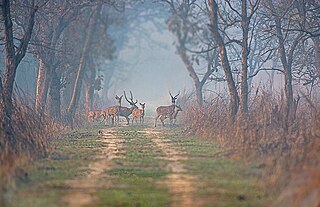
Dudhwa National Park is a national park in the Terai belt of marshy grasslands in northern Uttar Pradesh, India. It stretches over an area of 490.3 km2 (189.3 sq mi), with a buffer zone of 190 km2 (73 sq mi). It is part of the Dudhwa Tiger Reserve in the Kheri and Lakhimpur districts. The park is located on the Indo-Nepali border in the Lakhimpur Kheri District.
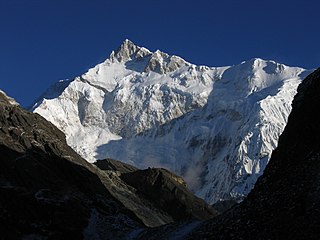
Khangchendzonga National Park, also Kanchenjunga Biosphere Reserve, is a national park and a biosphere reserve located in Sikkim, India. It was inscribed to the UNESCO World Heritage Sites list in July 2016, becoming the first "Mixed Heritage" site of India. It was included in the UNESCO Man and the Biosphere Programme. The park is named after the mountain Kangchenjunga, which is the third-highest peak in the world at 8,586 m (28,169 ft) tall. The total area of the park is 849.5 km2 (328.0 sq mi).

The Terai–Duar savanna and grasslands is a narrow lowland ecoregion at the base of the Himalayas, about 25 km (16 mi) wide, and a continuation of the Indo-Gangetic Plain in India, Nepal and Bhutan. It is colloquially called Terai in the Ganges Basin east to Nepal, then Dooars in West Bengal, Bhutan and Assam east to the Brahmaputra River. It harbours the world's tallest grasslands, which are the most threatened and rare worldwide.

Bardiya National Park is a protected area in Nepal that was established in 1988 as Royal Bardia National Park. Covering an area of 968 km2 (374 sq mi) it is the largest and most undisturbed national park in Nepal's Terai, adjoining the eastern bank of the Karnali River and bisected by the Babai River in the Bardiya District. Its northern limits are demarcated by the crest of the Siwalik Hills. The Nepalgunj-Surkhet highway partly forms the southern boundary, but seriously disrupts the protected area. Natural boundaries for human settlements are formed in the west by the Geruwa, a branch of the Karnali River, and in the southeast by the Babai River.

The Indian narrow-headed softshell turtle, also known as the small-headed softshell turtle or the Indo-Gangetic softshell turtle, is an endangered species of softshell turtle native to waterways and rivers of the Indian subcontinent. It is very large, feeding on fish, frogs, worms, crustaceans and molluscs, and even the occasional swimming small rodent or other mammal. C. indica, like other softshell turtles, uses it flexible shell to dig itself deep into sandy lake and river bottoms; here, it patiently waits for potential prey to swim by. They will also ambush and chase their prey, depending on availability, the time of year, and size of the prey. In the past it was included as a subspecies of Chitra chitra, a species restricted to Southeast Asia using current taxonomy.

Romulus Earl Whitaker is an American-born Indian herpetologist, wildlife conservationist, and founder of the Madras Snake Park, the Andaman and Nicobar Environment Trust (ANET), and the Madras Crocodile Bank Trust. In 2008, Whitaker was selected as an associate laureate in the 2008 Rolex Awards for Enterprise for his efforts to create a network of rainforest research stations throughout India. In 2005, he was a winner of a Whitley Award for outstanding leadership in nature conservation. He used this award to found the Agumbe Rainforest Research Station in Karnataka, for the study of king cobras and their habitat.

Kunwar "Billy" Arjan Singh was an Indian hunter turned conservationist and author. He was the first who tried to reintroduce tigers and leopards from captivity into the wild.
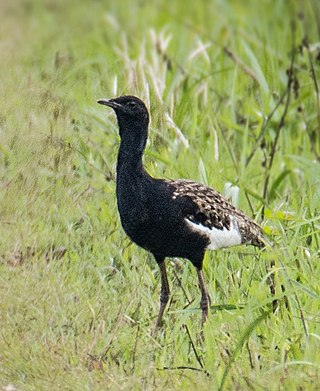
The Bengal florican, also called the Bengal bustard, is a bustard species native to the Indian subcontinent, Cambodia, and Vietnam. It is listed as Critically Endangered on the IUCN Red List because fewer than 1,000 individuals were estimated to be alive as of 2017. It is the only member of the genus Houbaropsis.

Lakhimpur is a city and a municipal board in the Lakhimpur Kheri district of the Indian state of Uttar Pradesh.
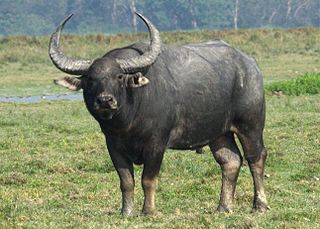
The wild water buffalo, also called Asian buffalo, Asiatic buffalo and wild buffalo, is a large bovine native to the Indian subcontinent and Southeast Asia. It has been listed as Endangered in the IUCN Red List since 1986, as the remaining population totals less than 4,000. A population decline of at least 50% over the last three generations is projected to continue. The global population has been estimated at 3,400 individuals, of which 3,100 (91%) live in India, mostly in Assam. The wild water buffalo is the most likely ancestor of the domestic water buffalo.

The Katarniaghat Wildlife Sanctuary is a protected area in the Upper Gangetic plain, near Bahraich city in Bahraich district of Uttar Pradesh, India and covers an area of 400.6 km2 (154.7 sq mi) in the Terai of the Bahraich district. In 1987, it was brought under the purview of the Project Tiger, and together with the Kishanpur Wildlife Sanctuary and the Dudhwa National Park it forms the Dudhwa Tiger Reserve. It was established in 1975.

The Dudhwa Tiger Reserve is a protected area in Uttar Pradesh that stretches mainly across the Lakhimpur Kheri and Bahraich districts and comprises the Dudhwa National Park, Kishanpur Wildlife Sanctuary and Katarniaghat Wildlife Sanctuary. It covers an area of 1,284.3 km2 (495.9 sq mi). Three large forested areas are extant within the reserve, although most of the surrounding landscape is agricultural. It shares the north-eastern boundary with Nepal, which is defined to a large extent by the Mohana River. It ranges in altitude from 110 to 185 m, and several streams flow through the reserve from the northwest across the alluvial plain that encompasses the reserve.

The Sharda River is the downstream of Kali River that originates in the northern Uttarakhand state of India in the Great Himalayas on the eastern slopes of Nanda Devi massif, at an elevation of 3,600 m (11,800 ft) in the Pithoragarh district. It then flows between the Nepal and India border. Descending, it enters the Indo-Gangetic Plain at Brahmadev Mandi in Nepal, where it expands above the Sharda Barrage. From that point onward, it is known as the Sharda River. The river proceeds southeastward into India through northern Uttar Pradesh before merging with the Ghaghara River southwest of Bahraich, covering a distance of approximately 300 miles.

Terai Arc Landscape (TAL) is composed of 14 Indian and Nepalese trans-border protected ecosystems of the Terai and nearby foothills of the Himalayas. and encompassing 14 protected areas of Nepal and India. The area spans approximately 12.3 million acres and includes Nepal's Bagmati River to the east and India's Yamuna River to the west. The TAL is home to many endangered mammals including the Bengal tiger, the Indian rhinoceros, the gaur, the wild Asian elephant, the hispid hare, the sloth bear, the South Asian river dolphin and the chital, as well as over 500 species of birds, many endangered. Examples of birds are the endangered Bengal florican, the sarus crane, and the black stork.
References
- ↑ Singh, B. (2009). Effect of water pollution on Pistia stratiotes in river Suheli of Dudhwa National Park and river Gomti of Lucknow city. Research in Environment and Life Sciences 2(3): 173–178.
- ↑ Kumar, S. (2009). "Retrieval of forest parameters from Envisat ASAR data for biomass inventory in Dudhwa National Park, U.P., India" Thesis submitted to Indian Institute of Remote Sensing and International Institute for Geo-information Science and Earth Observation.
- ↑ Tiwaru, P. C., Joshi, B. (1998). Wildlife in the Himalayan Foothills: Conservation and Management Indus Publishing, New Delhi.
- ↑ Reeves, R. R., Smith, B. D., Kasuya, T. (2000).Biology and Conservation of Freshwater Cetaceans in Asia. Issue 23 of IUCN Species Survival Commission Occasional Paper Series